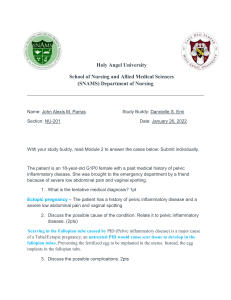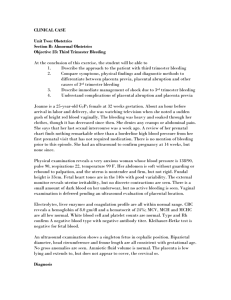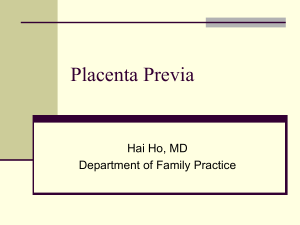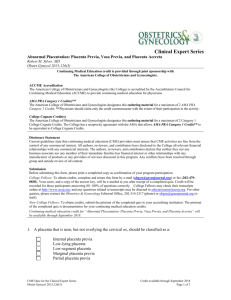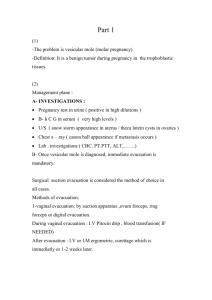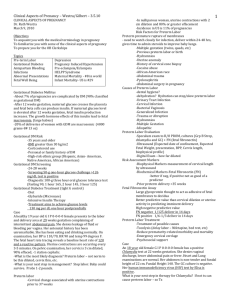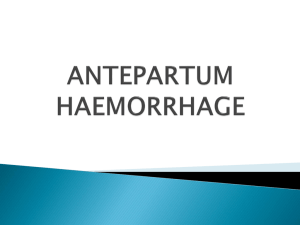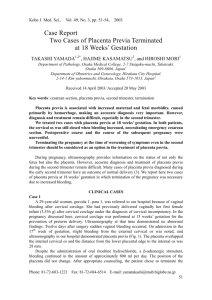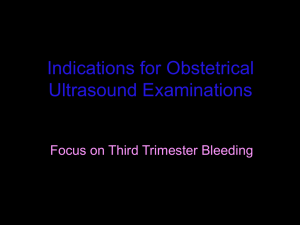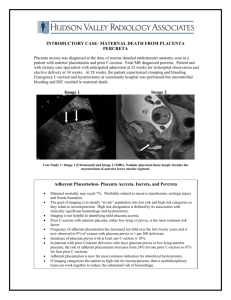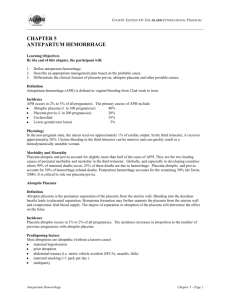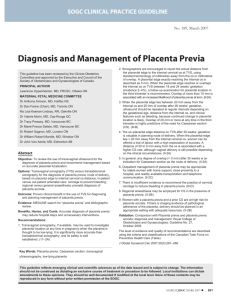Placenta Previa
advertisement
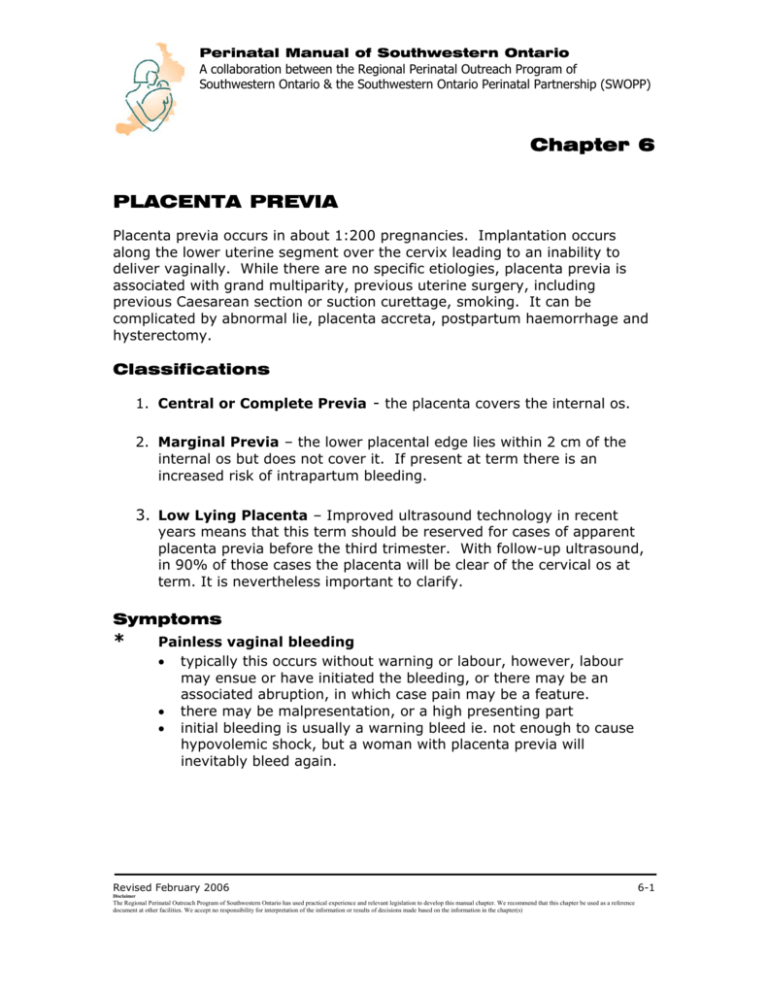
Perinatal Manual of Southwestern Ontario A collaboration between the Regional Perinatal Outreach Program of Southwestern Ontario & the Southwestern Ontario Perinatal Partnership (SWOPP) Chapter 6 PLACENTA PREVIA Placenta previa occurs in about 1:200 pregnancies. Implantation occurs along the lower uterine segment over the cervix leading to an inability to deliver vaginally. While there are no specific etiologies, placenta previa is associated with grand multiparity, previous uterine surgery, including previous Caesarean section or suction curettage, smoking. It can be complicated by abnormal lie, placenta accreta, postpartum haemorrhage and hysterectomy. Classifications 1. Central or Complete Previa - the placenta covers the internal os. 2. Marginal Previa – the lower placental edge lies within 2 cm of the internal os but does not cover it. If present at term there is an increased risk of intrapartum bleeding. 3. Low Lying Placenta – Improved ultrasound technology in recent years means that this term should be reserved for cases of apparent placenta previa before the third trimester. With follow-up ultrasound, in 90% of those cases the placenta will be clear of the cervical os at term. It is nevertheless important to clarify. Symptoms * Painless vaginal bleeding • typically this occurs without warning or labour, however, labour may ensue or have initiated the bleeding, or there may be an associated abruption, in which case pain may be a feature. • there may be malpresentation, or a high presenting part • initial bleeding is usually a warning bleed ie. not enough to cause hypovolemic shock, but a woman with placenta previa will inevitably bleed again. Revised February 2006 Disclaimer The Regional Perinatal Outreach Program of Southwestern Ontario has used practical experience and relevant legislation to develop this manual chapter. We recommend that this chapter be used as a reference document at other facilities. We accept no responsibility for interpretation of the information or results of decisions made based on the information in the chapter(s) 6-1 Perinatal Outreach Program of Southwestern Ontario PERINATAL MANUAL CHAPTER 6 – PLACENTA PREVIA Diagnosis 1. Ultrasound – transvaginal and translabial ultrasound are very useful (following the initial transabdominal scan) in accurately diagnosing or ruling out placenta previa, and measuring the distance, in centimeters, from the internal os to the placental edge. 2. No digital vaginal or rectal examinations until the placenta is localized and placenta previa is ruled out. 3. If patient needs delivery for fetal or maternal reasons, double set-up may be required. • Double set-up: refers to a digital exam being done to determine placental location, in the operating room with the anaesthetist present, assistants scrubbed and instruments prepared for immediate Caesarean section. Given improvements in ultrasound quality in recent years, and the availability of ultrasound, this is a rare necessity. Management • *If bleeding is severe, it may be necessary to deliver the infant and call for the neonatal transport team. • Remember that the woman with placenta previa will inevitably bleed again. • Stabilization and transfer will be necessary for level I units or centres with inadequate surgical and blood bank backup, or inadequate neonatal facilities. • Full discussion regarding possible need for blood products is necessary. Informed consent is required. 1. Assess maternal and fetal health 2. NPO 3. Start intravenous infusion of saline or Ringer’s lactate using a large bore needle • Blood replacement as deemed necessary (based on amount of bleeding and maternal vital signs) 4. Monitor intake and output. Insert urinary catheter if bleeding is severe Revised February 2006 6-2 Perinatal Outreach Program of Southwestern Ontario PERINATAL MANUAL CHAPTER 6 – PLACENTA PREVIA 5. Monitor maternal vital signs and fetal heart rate every 15 minutes while actively bleeding, and hourly once stable 6. Continuous fetal heart rate monitoring until active bleeding has stopped. 7. Assess the colour and amount of blood loss • Pad count • Weighing pads • Blood clots, number and size • Sequential CBC’s and coagulation status 8. Lab assessment • CBC, Hgb, Hct • Coagulation screen • Electrolytes, BUN, creatinine • Group and cross match 2-4 units packed red cells (take blood during transfer) 9. Assess uterine tone and presence of contractions 10.Strict bedrest in the lateral position 11.Communicate with staff at receiving hospital if patient being transferred 12.1:1 nursing care with nurse accompaniment during transport If the woman is retained in a level II centre, the following is also recommended: 1. Bedrest until active bleeding has stopped for 2 – 3 days 2. Assess and treat anemia 3. Consider steroid (betamethasone) administration. 4. Daily fetal movement counts and non-stress testing 5. Delivery at 37-38 weeks, unless indicated earlier for maternal or fetal reasons. A previous lower segment scar increases the risk of placeta accreta. Even without placenta accreta, the poor contractile ability of the lower uterine segment can contribute to major Revised February 2006 6-3 Perinatal Outreach Program of Southwestern Ontario PERINATAL MANUAL CHAPTER 6 – PLACENTA PREVIA haemorrhage for which the operator must be prepared and the patient consented to necessary interventions. Outpatient Management • Outpatient management of placenta previa is an option. However unit specific guidelines need to be developed for facilitation of such management. Suggested Readings 1. Baskett, T. F., Essential Management of Obstetric Emergencies, Clinical Press, Bristol, 1991. 2. The Society of Obstetricians and Gynecologists of Canada (SOGC), Alarm Course Syllabus, 11th ed., 2004. 3. Williams Obstetrics, 22nd edition 4. Maternal-Fetal Medicine, 4th edition Revised February 2006 6-4
